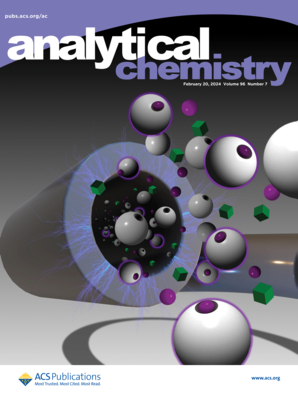Identification and Quantification of Multiple Pathogenic Escherichia coli Strains Based on a Plasmonic Sensor Array
IF 6.7
1区 化学
Q1 CHEMISTRY, ANALYTICAL
引用次数: 0
Abstract
Pathogenic Escherichia coli (E. coli) is a widespread and clinically significant foodborne pathogen. Due to its high mutation rates and phenotypic diversity, rapid identification of its subtypes remains challenging and prone to false positives when detecting single strains. In this study, we developed a plasmonic sensor array with high-dimensional signal readouts (ζ-potential, dynamic light-scattering (DLS), surface-enhanced Raman scattering (SERS), and ultraviolet–visible (UV–vis) absorption spectra) for the selective discrimination of pathogenic E. coli, integrated with bacterial culture methods. The plasmonic sensor units demonstrated strong encoding capabilities, facilitating the differentiation of subtle variations among various E. coli strains and showing excellent anti-interference performance. The array realized different pathogenic E. coli strains, bacterial mixture identification, and even quantitative detection. Remarkably, the working concentration for the sensor array was notably low, at 104 CFU/mL. Finally, by incorporating bacterial isolation culture, the designed sensor array obtained 100% accuracy in detecting E. coli in real food samples. These findings highlight the sensor array’s potential for applications in food safety monitoring and clinical diagnostics, offering a sensitive, rapid, and reliable tool for pathogen detection in complex samples.

基于等离子体传感器阵列的多致病性大肠杆菌菌株鉴定与定量
致病性大肠杆菌(E. coli)是一种广泛存在且对临床具有重要意义的食源性病原体。由于其突变率高、表型多样,快速识别其亚型仍具有挑战性,而且在检测单一菌株时容易出现假阳性。在这项研究中,我们开发了一种具有高维信号读出(ζ电位、动态光散射(DLS)、表面增强拉曼散射(SERS)和紫外-可见(UV-vis)吸收光谱)的质子传感器阵列,与细菌培养方法相结合,用于选择性地鉴别致病性大肠杆菌。质子传感器单元具有很强的编码能力,有助于区分各种大肠杆菌菌株之间的细微差异,并表现出卓越的抗干扰性能。该阵列实现了对不同致病性大肠杆菌菌株、细菌混合物的识别,甚至定量检测。值得注意的是,传感器阵列的工作浓度非常低,仅为 104 CFU/mL。最后,通过结合细菌分离培养,所设计的传感器阵列在检测真实食品样品中的大肠杆菌时获得了 100% 的准确率。这些发现凸显了传感器阵列在食品安全监控和临床诊断方面的应用潜力,为复杂样品中的病原体检测提供了灵敏、快速和可靠的工具。
本文章由计算机程序翻译,如有差异,请以英文原文为准。
求助全文
约1分钟内获得全文
求助全文
来源期刊

Analytical Chemistry
化学-分析化学
CiteScore
12.10
自引率
12.20%
发文量
1949
审稿时长
1.4 months
期刊介绍:
Analytical Chemistry, a peer-reviewed research journal, focuses on disseminating new and original knowledge across all branches of analytical chemistry. Fundamental articles may explore general principles of chemical measurement science and need not directly address existing or potential analytical methodology. They can be entirely theoretical or report experimental results. Contributions may cover various phases of analytical operations, including sampling, bioanalysis, electrochemistry, mass spectrometry, microscale and nanoscale systems, environmental analysis, separations, spectroscopy, chemical reactions and selectivity, instrumentation, imaging, surface analysis, and data processing. Papers discussing known analytical methods should present a significant, original application of the method, a notable improvement, or results on an important analyte.
 求助内容:
求助内容: 应助结果提醒方式:
应助结果提醒方式:


